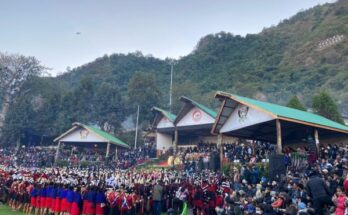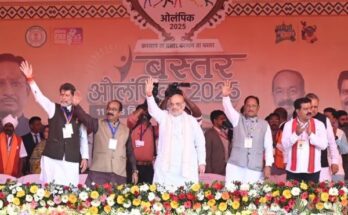
By Nava Thakuria
Unlike other Durga Puja mandaps showcasing splendid clay idols of Devi Maa, the celebration at Kamakhya temple nestled atop Nilachal hills traditionally avoids any idol worshiping.
The auspicious occasion symbolising the victory over the demon king Mahishasura (so Durga Devi is also known as Mahishasura Mardini) goes for a fortnight beginning with Krishna Navami and ending with Shukla Navami of Ahina. The rituals like Mahasnan (ritualistic bath of the deity), Pithasthan with Panchagarva, sacrifice of buffalo, goat, pigeon, fish, gourd, pumpkin, sugarcane etc are performed at the main Peeth (sanctum sanctorum).
Thousands of Hindu devotees from different parts of the country throng Kamakhya temple. The sacred temple, a major seat of Shakti worship, maintains the tradition of celebrating Durga Puja (also known as Durgotsav) annually during Shardiya Navratri festival where Devi’s nine incarnations are worshipped.
Popular beliefs go that Goddess Durga visits her maternal home on Earth with four children (Lakshmi, Saraswati, Karthik and Ganesh) and leaves for Kailash on Vijayadashami (this time falls on 24 October). The pujas (Nitya, Prata Madhya, Sainni, Sandhya Arati) are performed every day with offerings of bhog. On Maha Saptami the pigeons, goats, buffalos are sacrificed. On the eighth day of fortnight, a special bhog is offered. On Mahanavami, ducks are sacrificed and on the tenth day puja is performed in the morning and the Goddess is offered pantabhata along with fried dove meat.
During the rituals, temple doors remain closed for the devotees. Kumari Puja is also performed sacredly during Durga Puja. The virgin girls (Kumari) are worshipped as a manifestation of the Goddess Kamakhya. They are adorned with new red sari, vermilion (sindur), garlands, jewelries etc in the day long ritual. The philosophy behind Kumari Puja is to establish the value of women, where the maiden symbolizes the seed of power that regulates creation, stability and destruction.
Recognized as one of 51 Shakti Peeths of Goddess Durga, the famous temple of Kameswari (Goddess of desire) is believed to be built by Kamdev (God of lust) with the help of God Vishwakarma. According to the Hindu mythology, the demon king Narakasura of Pragjyotishpur constructed a stone path (known as Mekhela Ujowa Path) connecting the temple from foothills with the intent to marry Kamakhya Devi, though he failed. Later, Devi killed Narakasura with the help of Lord Vishnu.
Kalika Purana, an ancient work in Sanskrit describes Kamakhya as the deity to fulfill the desires of devotees and gives salvation. The temple however does not comprise any image or statue of Kamakhya, rather there is a sculptured image of Yoni in a cave inside the main temple. A natural spring believes to keep the stone always moist. The devotees touch the stone, draped with a silk sari, offer flowers & bel-paat on it and seek blessings.
Few other religious festivals, held at the Kamakhya temple premises annually include Ambubasi Mela, Basanti Puja, Shivaratri Mahotsav, Manasa Puja etc. The Ambubasi festival is associated with the legend of menstrual cycles of Devi Kamakhya. It is believed that the Devi menstruates during the period and hence the main temple remained closed for three days. Hundreds of thousands of devotees with Sadhus from different parts of the country and abroad gather in the temple premises to celebrate the festivals and have a Darshan of Kamakhya.
(The author is a senior and eminent journalist based in Guwahati)



